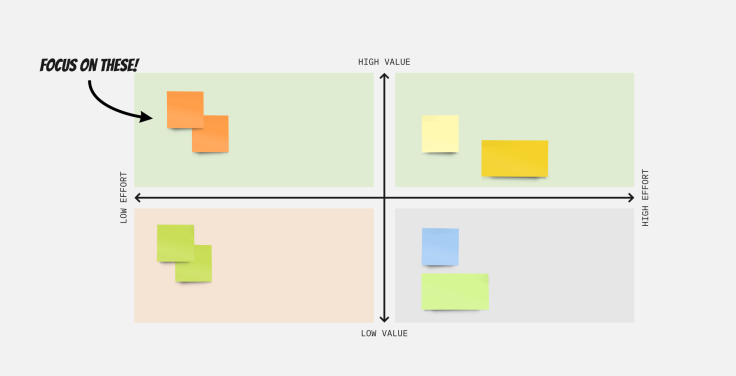How to move from qualitative data to actionable insights

You conducted a successful user research project, interviewing went well, and you managed to collect a fantastic amount of data. It’s a great feeling and one that makes me smile.
One of my first successful user research projects was a larger-scale discovery of how people used our SaaS platform daily. We targeted the right people, colleagues sat in on the interviews, and each participant gave us rich stories full of juicy information. I collected all of this information and ran my debrief and synthesis sessions.
After speaking to 25 people, the amount of data in front of us was vast and deep. At the end of synthesis, we had over 50 insights scattered throughout the different tags we used—pain points, goals, motivations—and no idea what to do next. Before this, my studies hadn’t been large enough to warrant prioritization. So instead, I would take the few insights that we created, and the teams would go about working on the ones that made sense. Sure, some insights went into the backlog, but the team immediately worked on most.
In this case, however, my teams looked to me to help them prioritize what was most important from the user’s perspective. Unfortunately, it can sometimes feel like everything is essential for a researcher, leaving me with no idea how to help. So I went to work researching how to go from the large amount of data we had to action items for the teams.
First, delineate between insights and other findings
When dealing with a large amount of qualitative data, you will likely have different levels of information. After creating an affinity diagram to highlight patterns in the data, I start by classifying the trends by:
Bugs. Often bugs come up under pain points and signal that something on your platform/service is not working as intended. I separate these from insights because the team should deal with them immediately (or as quickly as possible)
Usability issue. Usability issues also come through under pain points. These problems are generally issues with the experience on a platform/service. A typical case could be participants struggling with navigation or checkout flow. Ideally, these are easy to solve for and are “low-hanging fruit”
Preference/wish. When participants tell you what they think they want, they might be lying, but not on purpose. Humans are notoriously bad at predicting what we might want/need in the future. I put preferences and wishes separate to be further investigated later
Now, what happens when something you found doesn’t fit into these categories? You might have an insight on your hands! The way I define insights are:
A discovery about human behavior and the underlying motivations behind that behavior
Information that challenges what we believe about users and how they exist in the world
Knowledge that uncovers fundamental principles that drive us towards seeing users in a new way
If the data you collected falls into one of these buckets, you can move it into the insights pile.
Focus on your insights
Once you have classified your findings and insights, it is time to shift focus to the insights. I typically delineate the types of information we’ve found on my own and then invite colleagues to review the insights I have pulled out.
During this session, we review the insights to get colleagues familiar with what we learned, especially those who didn’t have the time to sit in on sessions. I typically give people 15 minutes to review the insights and, during that time, they write down any questions they have. We then answer as many questions as possible about the insights.
Once the team reviews the insights, it’s time to figure out the next steps. I have had teammates walk in and laugh (nervous laughter) at the number of insights we have and question how we will know what to do to move forward.
Time for prioritization
After everyone understands the insights properly, it is time to figure out which ones to focus on first. This part can be complicated since you need to involve the group in the prioritization process. There are many ways to prioritize insights, but here are some that I use the most often:
Dot voting. Dot voting is the most straightforward prioritization model, but it also comes with the caveat that those voting need to deeply understand customers and business needs. If your team checks this box, you can easily use this method. Depending on the number of insights, I give everyone a certain number of votes and ask them to vote on the most impactful insights. We then prioritize the insights with the votes
Spending money. Similar to dot-voting, using money is another way to help prioritize what to work on next. Everyone gets one hundred dollars (or whichever currency) to spend on the insights. They can spend as much or as little on each insight. We prioritize the insights with the most money
(R)ICE model. I use the (R)ICE model with product managers familiar with the process and teams less comfortable with our users. The RICE model looks at reach (how many people will the insight impact?), impact (how much value will this insight generate?), confidence (how confident are we this insight will positively impact/is helpful for users?), and effort (how much time will this insight take?). You may not have the answers to all of these questions, but they are good to think through
Effort versus impact matrix. If the above RICE model feels too complicated, the effort versus impact matrix might be a perfect compromise (you can find a template on Miro). Like above, the team decides how valuable the insight would be to customers and then determines the amount of time/effort it would take to fulfill that insight. You then prioritize the data that falls into the high impact and low effort area.

After the prioritization
Once you prioritize your insights, it is time to take action by creating ideas for addressing the insights. One of the best ways to act on insights is a brainstorming or ideation workshop.
Pick your topic or insight you want to focus on
Create a “How Might We” statement. For example, if your insight is about how people want to try on clothes before they buy them online, you can change this to “How might we allow people to know they are purchasing the right size/fit before they have to pay for the clothing?”
Pick an ideation technique. There are many ideation techniques, but my favorites are Flip the Problem, Crazy 8’s, Method 6-3-5, and Worst possible idea. Check out these links for even more ideas:
Innovation cards
Dot vote on the ideas—this is another round of prioritization—and pick the top two or three ideas
Follow up with usability testing on the ideas!
How do you decide what constitutes an insight and how do you action them? Do you have a pet prioritization model? Come join us on our community Slack channel to discuss this topic and all things research-related with 1000s of other active members.
Written by Nikki Anderson, User Research Lead & Instructor. Nikki is a User Research Lead and Instructor with over eight years of experience. She has worked in all different sizes of companies, ranging from a tiny start-up called ALICE to large corporation Zalando, and also as a freelancer. During this time, she has led a diverse range of end-to-end research projects across the world, specializing in generative user research. Nikki also owns her own company, User Research Academy, a community and education platform designed to help people get into the field of user research, or learn more about how user research impacts their current role. User Research Academy hosts online classes, content, as well as personalized mentorship opportunities with Nikki. She is extremely passionate about teaching and supporting others throughout their journey in user research. To spread the word of research and help others transition and grow in the field, she writes as a writer at dscout and Dovetail. Outside of the world of user research, you can find Nikki (happily) surrounded by animals, including her dog and two cats, reading on her Kindle, playing old-school video games like Pokemon and World of Warcraft, and writing fiction novels.
Art by Ben Jomo, Illustrator.



